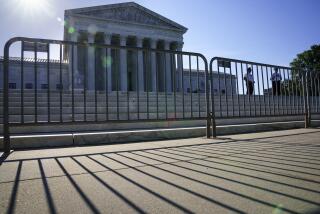Politicizing Judges at the Polls : Conservative Nature of the Judiciary Will Be Jeopardized
- Share via
It now appears that the campaign to oust three members of the California Supreme Court may well succeed. If so, conservative opponents of the justices will savor a victory that will seem sweet. But the ultimate cost of this short-term victory for conservatives may prove quite high.
Because of the manner in which our federal and state Supreme Court justices are appointed and traditionally have held office, the judiciary functions as a truly conservative institution, a brake on the ever-occurring shifts of popular political opinion. The executive appoints a new member to the high court only when a vacancy occurs, usually infrequently. Judicial tenure is thereafter relatively permanent. (In the federal system this is achieved by life tenure; in California by staggered, infrequent confirmation by the voters and, until now, a willingness by political leaders and the Bar to put aside politics in supporting justices and ensuring that debate did not focus on the court’s decisions.)
This system has produced a judicial institution that is deliberately not the product of the politics of the moment. Most judges on the U.S. Supreme Court or the state high courts at any given time were likely appointed by predecessors of current political officeholders--predecessors with political views often different from those later in vogue. Historically, therefore, it has taken time for a President or governor to transform the judiciary politically through the power of appointment.
The result has been a judiciary relatively insulated from current political passions, indeed often at odds with them. The political upheavals of the Great Depression swept into executive and legislative office liberal Democrats with radically new ideas about the role of government. Political reformation of the judiciary, however, took longer. Because it remained occupied for a long time largely by men with the conservative outlook of a prior era, the judiciary acted as a counterbalance to the sudden radical shift in political views of the nation--political passions at times impatient with seemingly outworn restraints of a 150-year-old Constitution.
We have recently seen another fundamental political shift, this time from left to right. The judiciary, as before, has been slower to reflect this change, and there remain on both the federal and state supreme courts what seems to conservatives to be a disproportionate number of judges whose views reflect the liberalism of yesterday.
This phenomenon is no historical accident. Alexander Hamilton argued in the Federalist Papers that a system where judges were not beholden to current political leaders, nor answerable to the people for the popularity of their decisions, was “peculiarly essential in a limited constitution.”
This is because the courts’ most important duties include review of the constitutional validity of popularly enacted measures, and protection of rights of unpopular individuals and classes against the passions of the majority. Neither political leaders nor the public are likely to look with favor upon a judiciary striking down or frustrating popular enactments.
This is precisely the wisdom of the current system, the key to its stabilizing conservative influence. Hamilton recognized that the greatest danger to a constitutional republic was from political passions of the moment. What better way to ensure against such dangers than to entrust the task of judicial review to an institution largely appointed by political predecessors, and not subject to removal because of unpopularity of its decisions?
Not surprisingly, this system, so inherently conservative, has historically provoked popular frustration. Franklin D. Roosevelt sought to short-cut the normally slow political transformation of the judiciary by “packing” the Supreme Court with judges more sympathetic to then-current liberal political wisdom. Thirty years later, at the start of the present political realignment, Gerald R. Ford led a short-lived congressional move to impeach liberal Justice William O. Douglas. In both cases thoughtful liberals and conservatives resisted the temptations of opportunism in favor of the stability of the institution.
Those same impulses of political frustration and opportunism are behind the campaign to oust Chief Justice Rose Elizabeth Bird and Justices Joseph Grodin and Cruz Reynoso, and replace them with judges who mirror more closely today’s political fashion.
This time the effort may succeed. If it does, in future Novembers those same conservatives may come to regret deeply this election effort. For as certain as the coastal waters, the political tides will ebb and flow.
And when political passions from the left have taken hold of the electorate and voice frustration at a conservative judiciary standing in the way of “progressive” reforms, the California campaign of 1986 will stand as a precedent for rapid political transformation of the judiciary at the polls. It is the conservative nature of the judiciary, not three liberal justices, which will have been defeated.
More to Read
Get the L.A. Times Politics newsletter
Deeply reported insights into legislation, politics and policy from Sacramento, Washington and beyond. In your inbox twice per week.
You may occasionally receive promotional content from the Los Angeles Times.










